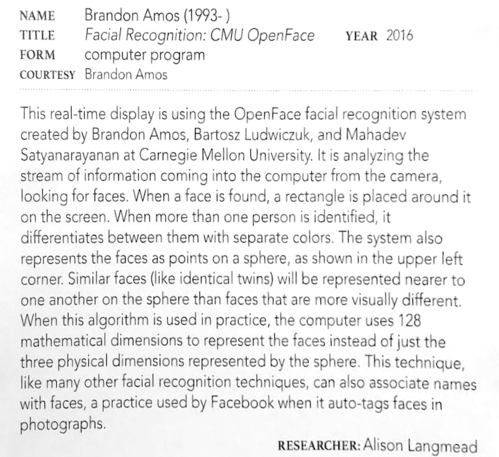83 lines
4.1 KiB
Markdown
83 lines
4.1 KiB
Markdown
## Demo 4: Real-Time Face Embedding Visualization
|
|
Released by [Brandon Amos](http://bamos.github.io) and
|
|
[Gabriel Farina](https://github.com/gabrfarina) on 2016-09-15.
|
|
|
|
---
|
|
|
|
We had a great opportunity
|
|
(*thanks to Jan Harkes, Alison Langmead, and Aaron Henderson*)
|
|
to present a short OpenFace demo
|
|
in the [Data (after)Lives art exhibit](https://uag.pitt.edu/Detail/occurrences/370)
|
|
at the University of Pittsburgh,
|
|
which investigates the relationship between the human notions of self and
|
|
technical alternative, externalized, and malleable representations of identity.
|
|
The following video is just a quick example, and a real-time version
|
|
is being shown live from Sept 8, 2016 to Oct 14, 2016.
|
|
We have released the source code behind this demo in our main
|
|
GitHub repository in
|
|
[demos/sphere.py](https://github.com/cmusatyalab/openface/blob/master/demos/sphere.py).
|
|
This exhibit also features [two other art pieces](https://raw.githubusercontent.com/cmusatyalab/openface/master/images/sphere-demo/exhibits-nosenzo.png)
|
|
by [Sam Nosenzo](http://www.pitt.edu/~san76/),
|
|
[Alison Langmead](http://www.haa.pitt.edu/person/alison-langmead/),
|
|
and [Aaron Henderson](http://www.aaronhenderson.com/) that use OpenFace.
|
|
|
|
|
|

|
|
|
|
<center>
|
|

|
|
</center>
|
|
|
|
### How this is implemented
|
|
|
|
This is a short description of our implementation in
|
|
[demos/sphere.py](https://github.com/cmusatyalab/openface/blob/master/demos/sphere.py),
|
|
which is only ~300 lines of code.
|
|
|
|
For a brief intro to OpenFace, we provide face recognition with
|
|
a deep neural network that embed faces on a sphere.
|
|
(See [our tech report](http://reports-archive.adm.cs.cmu.edu/anon/2016/CMU-CS-16-118.pdf)
|
|
for a more detailed intro to how OpenFace works.)
|
|
Faces are often embedded onto a 128-dimensional sphere.
|
|
For this demo, we re-trained a neural network to embed faces onto a
|
|
3-dimensional sphere that we show in real-time on top of a camera feed.
|
|
The 3-dimensional embedding doesn't have the same accuracy as the
|
|
128-dimensional embedding, but it's sufficient to illustrate how
|
|
the embedding space distinguishes between different people.
|
|
|
|
In this demo:
|
|
|
|
+ We first use [OpenCV](http://opencv.org/) to get, process, and display
|
|
a video feed from the camera.
|
|
+ The detected faces and embeddings for every face can be easily obtained with
|
|
[dlib](http://blog.dlib.net/) and OpenFace with
|
|
[a few lines of code](http://cmusatyalab.github.io/openface/usage/).
|
|
+ The color of the embedding is created by mapping the location of the
|
|
face in the frame to be a number between 0 and 1 and then using
|
|
a [matplotlib colormap](http://matplotlib.org/examples/color/colormaps_reference.html).
|
|
+ To keep all of the graphics on a single panel, we draw the sphere on
|
|
top of the same OpenCV buffer as the video.
|
|
[OpenCV only has 2D drawing primitives](http://docs.opencv.org/2.4/modules/core/doc/drawing_functions.html),
|
|
so we [isometrically project](https://en.wikipedia.org/wiki/Isometric_projection)
|
|
the points from the 3D sphere into 2D so we can use OpenCV's 2D drawing primitives.
|
|
+ Since the images from the video are noisy, the embeddings will jump around
|
|
a lot of the sphere if not dampened.
|
|
We smooth this out with
|
|
[dlib's object tracker](http://blog.dlib.net/2015/02/dlib-1813-released.html)
|
|
to track of a face's average (dampened) embedding throughout
|
|
the video frames.
|
|
+ Face detection and recognition cause the 'low' frame rate.
|
|
The frame rate could be improved by only doing detection and recognition
|
|
every few frames and using face tracking (which is fast) in between to
|
|
update the face locations.
|
|
|
|
### Running on your computer
|
|
|
|
To run this on your computer:
|
|
|
|
1. [Set up OpenFace](http://cmusatyalab.github.io/openface/setup/).
|
|
2. Download the 3D model from
|
|
[here](http://openface-models.storage.cmusatyalab.org/nn4.small2.3d.v1.t7).
|
|
3. Run [demos/sphere.py](https://github.com/cmusatyalab/openface/blob/master/demos/sphere.py)
|
|
with the `--networkModel` argument pointing to the 3D model.
|